How Do Deep Sea Animals Get Oxygen
| Animals Temporal range: Cryogenian – present, | |
|---|---|
| | |
| Scientific classification | |
| Domain: | Eukaryota |
| (unranked): | Amorphea |
| (unranked): | Obazoa |
| (unranked): | Opisthokonta |
| (unranked): | Holozoa |
| (unranked): | Filozoa |
| Kingdom: | Animalia Linnaeus, 1758 |
| Major divisions | |
| meet text | |
| Synonyms | |
| |
Animals (also chosen Metazoa) are multicellular, eukaryotic organisms in the biological kingdom Animalia. With few exceptions, animals eat organic textile, breathe oxygen, are able to move, can reproduce sexually, and go through an ontogenetic stage in which their body consists of a hollow sphere of cells, the blastula, during embryonic development. Over ane.five meg living animal species have been described—of which around 1 meg are insects—simply it has been estimated there are over vii million fauna species in total. Animals range in length from 8.5 micrometres (0.00033 in) to 33.6 metres (110 ft). They have complex interactions with each other and their environments, forming intricate food webs. The scientific study of animals is known every bit zoology.
About living animal species are in Bilateria, a clade whose members have a bilaterally symmetric body plan. The Bilateria include the protostomes, containing animals such equally nematodes, arthropods, flatworms, annelids and molluscs, and the deuterostomes, containing the echinoderms and the chordates, the latter including the vertebrates. Life forms interpreted as early on animals were nowadays in the Ediacaran biota of the late Precambrian. Many mod animal phyla became clearly established in the fossil record every bit marine species during the Cambrian explosion, which began effectually 539 meg years agone. 6,331 groups of genes common to all living animals have been identified; these may take arisen from a unmarried mutual ancestor that lived 650 one thousand thousand years ago.
Historically, Aristotle divided animals into those with blood and those without. Carl Linnaeus created the first hierarchical biological nomenclature for animals in 1758 with his Systema Naturae, which Jean-Baptiste Lamarck expanded into 14 phyla past 1809. In 1874, Ernst Haeckel divided the animal kingdom into the multicellular Metazoa (now synonymous for Animalia) and the Protozoa, single-celled organisms no longer considered animals. In modern times, the biological classification of animals relies on avant-garde techniques, such as molecular phylogenetics, which are effective at demonstrating the evolutionary relationships between taxa.
Humans make use of many brute species, such as for food (including meat, milk, and eggs), for materials (such as leather and wool), equally pets, and as working animals including for ship. Dogs have been used in hunting, every bit accept birds of casualty, while many terrestrial and aquatic animals were hunted for sports. Nonhuman animals have appeared in art from the earliest times and are featured in mythology and religion.
Etymology
The word fauna comes from the Latin animalis , pregnant 'having breath', 'having soul' or 'living existence'.[1] The biological definition includes all members of the kingdom Animalia.[2] In vernacular usage, the term creature is oftentimes used to refer but to nonhuman animals.[three] [four] [five] [6]
Characteristics

Animals are unique in having the ball of cells of the early embryo (i) develop into a hollow brawl or blastula (2).
Animals have several characteristics that set them apart from other living things. Animals are eukaryotic and multicellular.[seven] [viii] Unlike plants and algae, which produce their own nutrients,[nine] animals are heterotrophic,[8] [10] feeding on organic textile and digesting it internally.[11] With very few exceptions, (instance; Henneguya zschokkei [12]) animals respire aerobically.[xiii] All animals are motile[xiv] (able to spontaneously movement their bodies) during at least part of their life cycle, merely some animals, such equally sponges, corals, mussels, and barnacles, later become sessile. The blastula is a stage in embryonic development that is unique to animals,[15] (though it has been lost in some) assuasive cells to be differentiated into specialised tissues and organs.
Construction
All animals are composed of cells, surrounded by a feature extracellular matrix equanimous of collagen and elastic glycoproteins.[16] During evolution, the brute extracellular matrix forms a relatively flexible framework upon which cells tin move nearly and be reorganised, making the formation of complex structures possible. This may exist calcified, forming structures such as shells, basic, and spicules.[17] In contrast, the cells of other multicellular organisms (primarily algae, plants, and fungi) are held in place past cell walls, and so develop by progressive growth.[eighteen] Animal cells uniquely possess the jail cell junctions called tight junctions, gap junctions, and desmosomes.[19]
With few exceptions—in particular, the sponges and placozoans—animal bodies are differentiated into tissues.[20] These include muscles, which enable locomotion, and nerve tissues, which transmit signals and coordinate the body. Typically, at that place is too an internal digestive bedchamber with either 1 opening (in Ctenophora, Cnidaria, and flatworms) or two openings (in most bilaterians).[21]
Reproduction and development

Nearly all animals make utilize of some form of sexual reproduction.[22] They produce haploid gametes past meiosis; the smaller, motile gametes are spermatozoa and the larger, non-motile gametes are ova.[23] These fuse to form zygotes,[24] which develop via mitosis into a hollow sphere, called a blastula. In sponges, blastula larvae swim to a new location, adhere to the seabed, and develop into a new sponge.[25] In most other groups, the blastula undergoes more complicated rearrangement.[26] It first invaginates to class a gastrula with a digestive chamber and 2 separate germ layers, an external ectoderm and an internal endoderm.[27] In near cases, a third germ layer, the mesoderm, likewise develops between them.[28] These germ layers then differentiate to form tissues and organs.[29]
Repeated instances of mating with a close relative during sexual reproduction by and large leads to inbreeding low within a population due to the increased prevalence of harmful recessive traits.[xxx] [31] Animals have evolved numerous mechanisms for avoiding shut inbreeding.[32]
Some animals are capable of asexual reproduction, which often results in a genetic clone of the parent. This may accept place through fragmentation; budding, such as in Hydra and other cnidarians; or parthenogenesis, where fertile eggs are produced without mating, such as in aphids.[33] [34]
Ecology
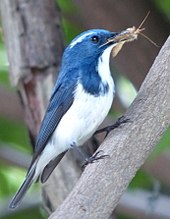
Animals are categorised into ecological groups depending on how they obtain or swallow organic fabric, including carnivores, herbivores, omnivores, detritivores,[35] and parasites.[36] Interactions between animals form complex food webs. In cannibal or omnivorous species, predation is a consumer–resources interaction where a predator feeds on another organism (called its casualty).[37] Selective pressures imposed on one another lead to an evolutionary arms race between predator and prey, resulting in various anti-predator adaptations.[38] [39] Almost all multicellular predators are animals.[xl] Some consumers apply multiple methods; for example, in parasitoid wasps, the larvae feed on the hosts' living tissues, killing them in the process,[41] only the adults primarily swallow nectar from flowers.[42] Other animals may accept very specific feeding behaviours, such as hawksbill sea turtles primarily eating sponges.[43]

Most animals rely on the biomass and free energy produced past plants through photosynthesis. Herbivores eat plant textile straight, while carnivores, and other animals on higher trophic levels typically acquire it indirectly by eating other animals. Animals oxidize carbohydrates, lipids, proteins, and other biomolecules, which allows the animal to grow and to sustain biological processes such as locomotion.[44] [45] [46] Animals living shut to hydrothermal vents and cold seeps on the nighttime ocean floor eat organic matter of archaea and leaner produced in these locations through chemosynthesis (by oxidizing inorganic compounds, such as hydrogen sulfide).[47]
Animals originally evolved in the body of water. Lineages of arthropods colonised land around the aforementioned fourth dimension as country plants, probably between 510 and 471 1000000 years agone during the Late Cambrian or Early on Ordovician.[48] Vertebrates such equally the lobe-finned fish Tiktaalik started to movement on to state in the belatedly Devonian, about 375 meg years agone.[49] [l] Animals occupy virtually all of earth's habitats and microhabitats, including salt water, hydrothermal vents, fresh water, hot springs, swamps, forests, pastures, deserts, air, and the interiors of animals, plants, fungi and rocks.[51] Animals are withal non especially heat tolerant; very few of them can survive at abiding temperatures above 50 °C (122 °F).[52] Only very few species of animals (mostly nematodes) inhabit the virtually extreme cold deserts of continental Antarctica.[53]
Diversity
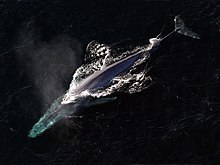
The bluish whale is the largest creature that has ever lived.
Size
The blue whale (Balaenoptera musculus) is the largest brute that has e'er lived, weighing up to 190 tonnes and measuring upwards to 33.6 metres (110 ft) long.[54] [55] [56] The largest extant terrestrial animal is the African bush elephant (Loxodonta africana), weighing upwards to 12.25 tonnes[54] and measuring up to ten.67 metres (35.0 ft) long.[54] The largest terrestrial animals that ever lived were titanosaur sauropod dinosaurs such equally Argentinosaurus, which may accept weighed as much as 73 tonnes.[57] Several animals are microscopic; some Myxozoa (obligate parasites within the Cnidaria) never grow larger than 20 µm,[58] and one of the smallest species (Myxobolus shekel) is no more than 8.5 µm when fully grown.[59]
Numbers and habitats
The post-obit tabular array lists estimated numbers of described extant species for the animal groups with the largest numbers of species,[sixty] along with their principal habitats (terrestrial, fresh h2o,[61] and marine),[62] and free-living or parasitic ways of life.[63] Species estimates shown here are based on numbers described scientifically; much larger estimates accept been calculated based on various means of prediction, and these can vary wildly. For instance, around 25,000–27,000 species of nematodes take been described, while published estimates of the total number of nematode species include x,000–20,000; 500,000; 10 million; and 100 million.[64] Using patterns within the taxonomic hierarchy, the total number of animal species—including those not yet described—was calculated to be about 7.77 million in 2011.[65] [66] [a]
| Phylum | Instance | No. of Species | Land | Ocean | Fresh water | Free- living | Parasitic |
|---|---|---|---|---|---|---|---|
| Arthropods |  | 1,257,000[60] | one,000,000 (insects)[68] | >xl,000 (Malac- ostraca)[69] | 94,000[61] | Yeah[62] | >45,000[b] [63] |
| Molluscs |  | 85,000[threescore] 107,000[70] | 35,000[lxx] | 60,000[70] | 5,000[61] 12,000[seventy] | Aye[62] | >five,600[63] |
| Chordates |  | >70,000[lx] [71] | 23,000[72] | thirteen,000[72] | 18,000[61] 9,000[72] | Aye | forty (catfish)[73] [63] |
| Platyhelminthes |  | 29,500[60] | Yes[74] | Aye[62] | 1,300[61] | Yeah[62] 3,000–6,500[75] | >40,000[63] four,000–25,000[75] |
| Nematodes |  | 25,000[threescore] | Yeah (soil)[62] | 4,000[64] | 2,000[61] | eleven,000[64] | 14,000[64] |
| Annelids |  | 17,000[60] | Yep (soil)[62] | Yes[62] | i,750[61] | Yep | 400[63] |
| Cnidaria |  | xvi,000[60] | Yep[62] | Yeah (few)[62] | Yep[62] | >1,350 (Myxozoa)[63] | |
| Sponges |  | x,800[60] | Yes[62] | 200-300[61] | Yeah | Aye[76] | |
| Echinoderms |  | seven,500[lx] | seven,500[threescore] | Yes[62] | |||
| Bryozoa |  | half-dozen,000[threescore] | Yes[62] | 60–eighty[61] | Yes | ||
| Rotifers |  | ii,000[lx] | >400[77] | ii,000[61] | Yes | ||
| Full number of described extant species as of 2013[update]: 1,525,728[lx] | |||||||
Evolutionary origin
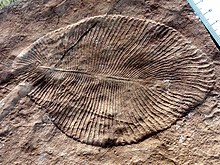
The first fossils that might represent animals appear in the 665-million-year-old rocks of the Trezona Formation of South Commonwealth of australia. These fossils are interpreted as almost probably being early sponges.[79]
Animals are institute as long ago every bit the Ediacaran biota, towards the end of the Precambrian, and perhaps somewhat earlier. Information technology had long been doubted whether these life-forms included animals,[fourscore] [81] [82] merely the discovery of the animal lipid cholesterol in fossils of Dickinsonia establishes their nature.[78] Animals are thought to have originated under low-oxygen weather, suggesting that they were capable of living entirely past anaerobic respiration, but as they became specialized for aerobic metabolism they became fully dependent on oxygen in their environments.[83]
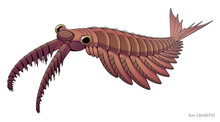
Many fauna phyla first appear in the fossil record during the Cambrian explosion, starting most 539 million years ago, in beds such as the Burgess shale.[84] Extant phyla in these rocks include molluscs, brachiopods, onychophorans, tardigrades, arthropods, echinoderms and hemichordates, along with numerous now-extinct forms such as the predatory Anomalocaris. The apparent suddenness of the event may notwithstanding exist an artefact of the fossil record, rather than showing that all these animals appeared simultaneously.[85] [86] [87] [88]
Some palaeontologists have suggested that animals appeared much earlier than the Cambrian explosion, possibly as early equally 1 billion years agone.[89] Trace fossils such every bit tracks and burrows establish in the Tonian catamenia may indicate the presence of triploblastic worm-like animals, roughly as large (most 5 mm wide) and complex every bit earthworms.[90] However, similar tracks are produced today past the giant single-celled protist Gromia sphaerica, so the Tonian trace fossils may not indicate early brute evolution.[91] [92] Effectually the same time, the layered mats of microorganisms called stromatolites decreased in diversity, perhaps due to grazing by newly evolved animals.[93]
Phylogeny
Animals are monophyletic, meaning they are derived from a common antecedent. Animals are sister to the Choanoflagellata, with which they form the Choanozoa.[94] The most basal animals, the Porifera, Ctenophora, Cnidaria, and Placozoa, have body plans that lack bilateral symmetry. Their relationships are still disputed; the sis group to all other animals could be the Porifera or the Ctenophora,[95] both of which lack hox genes, important in body plan development.[96]
These genes are establish in the Placozoa[97] [98] and the higher animals, the Bilateria.[99] [100] 6,331 groups of genes mutual to all living animals accept been identified; these may have arisen from a single common antecedent that lived 650 million years ago in the Precambrian. 25 of these are novel core factor groups, institute just in animals; of those, 8 are for essential components of the Wnt and TGF-beta signalling pathways which may have enabled animals to go multicellular by providing a pattern for the body's system of axes (in 3 dimensions), and another 7 are for transcription factors including homeodomain proteins involved in the control of development.[101] [102]
The phylogenetic tree (of major lineages only) indicates approximately how many millions of years ago (mya) the lineages split.[103] [104] [105] [106] [107]
Non-bilateria

Non-bilaterians include sponges (eye) and corals (background).
Several brute phyla lack bilateral symmetry. Amidst these, the sponges (Porifera) probably diverged outset, representing the oldest creature phylum.[108] Sponges lack the complex organization found in most other beast phyla;[109] their cells are differentiated, merely in most cases not organised into distinct tissues.[110] They typically feed by drawing in water through pores.[111]
The Ctenophora (comb jellies) and Cnidaria (which includes jellyfish, sea anemones, and corals) are radially symmetric and take digestive chambers with a single opening, which serves as both mouth and anus.[112] Animals in both phyla have singled-out tissues, only these are not organised into organs.[113] They are diploblastic, having only two main germ layers, ectoderm and endoderm.[114] The tiny placozoans are similar, just they do non have a permanent digestive chamber.[115] [116]
Bilateria
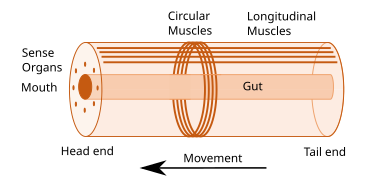
Idealised bilaterian body plan.[c] With an elongated body and a direction of movement the fauna has head and tail ends. Sense organs and mouth class the basis of the head. Opposed round and longitudinal muscles enable peristaltic movement.
The remaining animals, the great bulk—comprising some 29 phyla and over a 1000000 species—form a clade, the Bilateria. The body is triploblastic, with three well-developed germ layers, and their tissues form distinct organs. The digestive chamber has two openings, a mouth and an anus, and there is an internal body cavity, a coelom or pseudocoelom. Animals with this bilaterally symmetric body program and a tendency to motility in one direction have a caput end (anterior) and a tail cease (posterior) every bit well as a back (dorsal) and a abdomen (ventral); therefore they also have a left side and a right side.[117] [118]
Having a front end finish means that this part of the trunk encounters stimuli, such as food, favouring cephalisation, the development of a head with sense organs and a mouth. Many bilaterians have a combination of circular muscles that constrict the torso, making information technology longer, and an opposing set of longitudinal muscles, that shorten the trunk;[118] these enable soft-bodied animals with a hydrostatic skeleton to move by peristalsis.[119] They also have a gut that extends through the basically cylindrical torso from mouth to anus. Many bilaterian phyla have master larvae which swim with cilia and have an apical organ containing sensory cells. However, there are exceptions to each of these characteristics; for case, developed echinoderms are radially symmetric (unlike their larvae), while some parasitic worms have extremely simplified trunk structures.[117] [118]
Genetic studies have considerably changed zoologists' understanding of the relationships inside the Bilateria. Near announced to belong to two major lineages, the protostomes and the deuterostomes.[120] The basalmost bilaterians are the Xenacoelomorpha.[121] [122] [123]
Protostomes and deuterostomes
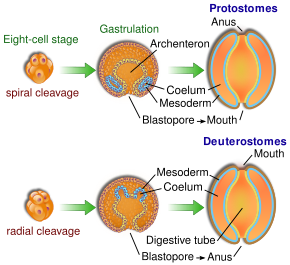
The bilaterian gut develops in ii ways. In many protostomes, the blastopore develops into the mouth, while in deuterostomes it becomes the anus.
Protostomes and deuterostomes differ in several means. Early on in development, deuterostome embryos undergo radial cleavage during cell division, while many protostomes (the Spiralia) undergo spiral cleavage.[124] Animals from both groups possess a complete digestive tract, just in protostomes the offset opening of the embryonic gut develops into the rima oris, and the anus forms secondarily. In deuterostomes, the anus forms first while the mouth develops secondarily.[125] [126] Most protostomes have schizocoelous development, where cells simply fill up in the interior of the gastrula to class the mesoderm. In deuterostomes, the mesoderm forms past enterocoelic pouching, through invagination of the endoderm.[127]
The main deuterostome phyla are the Echinodermata and the Chordata.[128] Echinoderms are exclusively marine and include starfish, sea urchins, and ocean cucumbers.[129] The chordates are dominated by the vertebrates (animals with backbones),[130] which consist of fishes, amphibians, reptiles, birds, and mammals.[131] The deuterostomes also include the Hemichordata (acorn worms).[132] [133]
Ecdysozoa
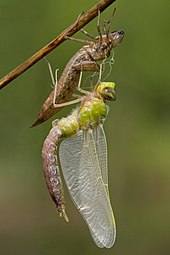
The Ecdysozoa are protostomes, named subsequently their shared trait of ecdysis, growth past moulting.[134] They include the largest brute phylum, the Arthropoda, which contains insects, spiders, crabs, and their kin. All of these have a torso divided into repeating segments, typically with paired appendages. 2 smaller phyla, the Onychophora and Tardigrada, are shut relatives of the arthropods and share these traits. The ecdysozoans besides include the Nematoda or roundworms, possibly the second largest animal phylum. Roundworms are typically microscopic, and occur in nearly every environment where there is water;[135] some are of import parasites.[136] Smaller phyla related to them are the Nematomorpha or horsehair worms, and the Kinorhyncha, Priapulida, and Loricifera. These groups have a reduced coelom, called a pseudocoelom.[137]
Spiralia

The Spiralia are a big group of protostomes that develop by spiral cleavage in the early embryo.[138] The Spiralia'due south phylogeny has been disputed, but information technology contains a large clade, the superphylum Lophotrochozoa, and smaller groups of phyla such as the Rouphozoa which includes the gastrotrichs and the flatworms. All of these are grouped every bit the Platytrochozoa, which has a sis group, the Gnathifera, which includes the rotifers.[139] [140]
The Lophotrochozoa includes the molluscs, annelids, brachiopods, nemerteans, bryozoa and entoprocts.[139] [141] [142] The molluscs, the second-largest animal phylum by number of described species, includes snails, clams, and squids, while the annelids are the segmented worms, such as earthworms, lugworms, and leeches. These two groups take long been considered close relatives because they share trochophore larvae.[143] [144]
History of nomenclature

Jean-Baptiste de Lamarck led the cosmos of a modern nomenclature of invertebrates, breaking upwardly Linnaeus'south "Vermes" into 9 phyla by 1809.[145]
In the classical era, Aristotle divided animals,[d] based on his own observations, into those with claret (roughly, the vertebrates) and those without. The animals were then bundled on a calibration from human (with blood, 2 legs, rational soul) downwards through the live-bearing tetrapods (with claret, 4 legs, sensitive soul) and other groups such equally crustaceans (no blood, many legs, sensitive soul) down to spontaneously generating creatures like sponges (no blood, no legs, vegetable soul). Aristotle was uncertain whether sponges were animals, which in his system ought to take sensation, appetite, and locomotion, or plants, which did non: he knew that sponges could sense touch on, and would contract if near to be pulled off their rocks, only that they were rooted similar plants and never moved nearly.[146]
In 1758, Carl Linnaeus created the first hierarchical classification in his Systema Naturae.[147] In his original scheme, the animals were ane of 3 kingdoms, divided into the classes of Vermes, Insecta, Pisces, Amphibia, Aves, and Mammalia. Since then the last four have all been subsumed into a unmarried phylum, the Chordata, while his Insecta (which included the crustaceans and arachnids) and Vermes have been renamed or broken upwardly. The procedure was begun in 1793 past Jean-Baptiste de Lamarck, who called the Vermes une espèce de chaos (a chaotic mess)[eastward] and dissever the group into iii new phyla, worms, echinoderms, and polyps (which contained corals and jellyfish). By 1809, in his Philosophie Zoologique, Lamarck had created 9 phyla apart from vertebrates (where he nevertheless had 4 phyla: mammals, birds, reptiles, and fish) and molluscs, namely cirripedes, annelids, crustaceans, arachnids, insects, worms, radiates, polyps, and infusorians.[145]
In his 1817 Le Règne Animal, Georges Cuvier used comparative anatomy to group the animals into 4 embranchements ("branches" with different trunk plans, roughly respective to phyla), namely vertebrates, molluscs, articulated animals (arthropods and annelids), and zoophytes (radiata) (echinoderms, cnidaria and other forms).[149] This division into four was followed by the embryologist Karl Ernst von Baer in 1828, the zoologist Louis Agassiz in 1857, and the comparative anatomist Richard Owen in 1860.[150]
In 1874, Ernst Haeckel divided the animal kingdom into two subkingdoms: Metazoa (multicellular animals, with v phyla: coelenterates, echinoderms, articulates, molluscs, and vertebrates) and Protozoa (unmarried-celled animals), including a sixth animal phylum, sponges.[151] [150] The protozoa were afterward moved to the former kingdom Protista, leaving only the Metazoa equally a synonym of Animalia.[152]
In human civilisation
Practical uses
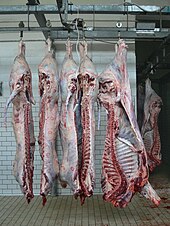
The man population exploits a big number of other animate being species for food, both of domesticated livestock species in animal husbandry and, mainly at ocean, by hunting wild species.[153] [154] Marine fish of many species are caught commercially for food. A smaller number of species are farmed commercially.[153] [155] [156] Humans and their livestock brand up more than ninety% of the biomass of all terrestrial vertebrates, and nearly as much as all insects combined.[157]
Invertebrates including cephalopods, crustaceans, and bivalve or gastropod molluscs are hunted or farmed for food.[158] Chickens, cattle, sheep, pigs, and other animals are raised as livestock for meat across the world.[154] [159] [160] Beast fibres such as wool are used to make textiles, while animal sinews have been used as lashings and bindings, and leather is widely used to brand shoes and other items. Animals have been hunted and farmed for their fur to make items such as coats and hats.[161] Dyestuffs including carmine (cochineal),[162] [163] shellac,[164] [165] and kermes[166] [167] have been made from the bodies of insects. Working animals including cattle and horses have been used for work and transport from the get-go days of agronomics.[168]
Animals such as the fruit fly Drosophila melanogaster serve a major function in scientific discipline equally experimental models.[169] [170] [171] [172] Animals take been used to create vaccines since their discovery in the 18th century.[173] Some medicines such as the cancer drug Yondelis are based on toxins or other molecules of animal origin.[174]
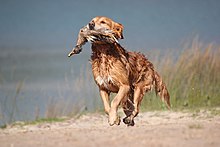
A gun dog retrieving a duck during a chase
People have used hunting dogs to assistance chase downward and recall animals,[175] and birds of prey to grab birds and mammals,[176] while tethered cormorants accept been used to catch fish.[177] Poison dart frogs have been used to poison the tips of blowpipe darts.[178] [179] A wide variety of animals are kept as pets, from invertebrates such as tarantulas and octopuses, insects including praying mantises,[180] reptiles such as snakes and chameleons,[181] and birds including canaries, parakeets, and parrots[182] all finding a place. However, the most kept pet species are mammals, namely dogs, cats, and rabbits.[183] [184] [185] There is a tension between the role of animals as companions to humans, and their beingness every bit individuals with rights of their own.[186] A broad variety of terrestrial and aquatic animals are hunted for sport.[187]
Symbolic uses

Animals have been the subjects of art from the earliest times, both historical, equally in Ancient Egypt, and prehistoric, as in the cave paintings at Lascaux. Major animal paintings include Albrecht Dürer's 1515 The Rhinoceros, and George Stubbs's c. 1762 horse portrait Whistlejacket.[188] Insects, birds and mammals play roles in literature and film,[189] such every bit in giant bug movies.[190] [191] [192]
Animals including insects[193] and mammals[194] feature in mythology and organized religion. In both Nihon and Europe, a butterfly was seen as the personification of a person's soul,[193] [195] [196] while the scarab protrude was sacred in aboriginal Arab republic of egypt.[197] Among the mammals, cattle,[198] deer,[194] horses,[199] lions,[200] bats,[201] bears,[202] and wolves[203] are the subjects of myths and worship. The signs of the Western and Chinese zodiacs are based on animals.[204] [205]
Encounter also
- Animal attacks
- Animal coloration
- Ethology
- Fauna
- Listing of creature names
- Lists of organisms past population
Notes
- ^ The application of DNA barcoding to taxonomy further complicates this; a 2016 barcoding analysis estimated a total count of near 100,000 insect species for Canada alone, and extrapolated that the global insect fauna must be in excess of ten 1000000 species, of which virtually 2 million are in a unmarried fly family unit known equally gall midges (Cecidomyiidae).[67]
- ^ Non including parasitoids.[63]
- ^ Compare File:Annelid redone w white background.svg for a more than specific and detailed model of a particular phylum with this general body plan.
- ^ In his History of Animals and Parts of Animals.
- ^ The prefix une espèce de is debasing.[148]
References
- ^ Cresswell, Julia (2010). The Oxford Dictionary of Discussion Origins (second ed.). New York: Oxford University Press. ISBN978-0-19-954793-vii.
'having the jiff of life', from anima 'air, breath, life'.
- ^ "Animal". The American Heritage Dictionary (4th ed.). Houghton Mifflin. 2006.
- ^ "animal". English Oxford Living Dictionaries. Archived from the original on 26 July 2018. Retrieved 26 July 2018.
- ^ Boly, Melanie; Seth, Anil 1000.; Wilke, Melanie; Ingmundson, Paul; Baars, Bernard; Laureys, Steven; Edelman, David; Tsuchiya, Naotsugu (2013). "Consciousness in humans and non-human animals: contempo advances and hereafter directions". Frontiers in Psychology. 4: 625. doi:10.3389/fpsyg.2013.00625. PMC3814086. PMID 24198791.
- ^ "The use of non-human animals in research". Royal Society. Archived from the original on 12 June 2018. Retrieved 7 June 2018.
- ^ "Nonhuman definition and meaning". Collins English Dictionary. Archived from the original on 12 June 2018. Retrieved seven June 2018.
- ^ Avila, Vernon L. (1995). Biological science: Investigating Life on Globe. Jones & Bartlett Learning. pp. 767–. ISBN978-0-86720-942-6.
- ^ a b "Palaeos:Metazoa". Palaeos. Archived from the original on 28 February 2018. Retrieved 25 February 2018.
- ^ Davidson, Michael W. "Animal Cell Structure". Archived from the original on 20 September 2007. Retrieved 20 September 2007.
- ^ Bergman, Jennifer. "Heterotrophs". Archived from the original on 29 August 2007. Retrieved 30 September 2007.
- ^ Douglas, Angela East.; Raven, John A. (Jan 2003). "Genomes at the interface betwixt bacteria and organelles". Philosophical Transactions of the Royal Society B. 358 (1429): 5–17. doi:ten.1098/rstb.2002.1188. PMC1693093. PMID 12594915.
- ^ Andrew, Scottie (26 Feb 2020). "Scientists discovered the starting time brute that doesn't need oxygen to live. It'southward changing the definition of what an animal can exist". CNN. Archived from the original on ten January 2022. Retrieved 28 Feb 2020.
- ^ Mentel, Marek; Martin, William (2010). "Anaerobic animals from an ancient, anoxic ecological niche". BMC Biology. 8: 32. doi:10.1186/1741-7007-8-32. PMC2859860. PMID 20370917.
- ^ Saupe, S. G. "Concepts of Biology". Archived from the original on 21 November 2007. Retrieved 30 September 2007.
- ^ Minkoff, Eli C. (2008). Barron's EZ-101 Study Keys Series: Biology (2d, revised ed.). Barron'south Educational Serial. p. 48. ISBN978-0-7641-3920-8.
- ^ Alberts, Bruce; Johnson, Alexander; Lewis, Julian; Raff, Martin; Roberts, Keith; Walter, Peter (2002). Molecular Biological science of the Cell (4th ed.). Garland Scientific discipline. ISBN978-0-8153-3218-three. Archived from the original on 23 December 2016. Retrieved 29 August 2017.
- ^ Sangwal, Keshra (2007). Additives and crystallization processes: from fundamentals to applications . John Wiley and Sons. p. 212. ISBN978-0-470-06153-4.
- ^ Becker, Wayne Chiliad. (1991). The world of the cell. Benjamin/Cummings. ISBN978-0-8053-0870-ix.
- ^ Magloire, Kim (2004). Cracking the AP Biology Examination, 2004–2005 Edition. The Princeton Review. p. 45. ISBN978-0-375-76393-9.
- ^ Starr, Cecie (2007). Biology: Concepts and Applications without Physiology. Cengage Learning. pp. 362, 365. ISBN978-0-495-38150-ane. Archived from the original on 26 July 2020. Retrieved 19 May 2020.
- ^ Hillmer, Gero; Lehmann, Ulrich (1983). Fossil Invertebrates. Translated by J. Lettau. CUP Archive. p. 54. ISBN978-0-521-27028-1. Archived from the original on seven May 2016. Retrieved 8 Jan 2016.
- ^ Knobil, Ernst (1998). Encyclopedia of reproduction, Book 1. Bookish Press. p. 315. ISBN978-0-12-227020-8.
- ^ Schwartz, Jill (2010). Chief the GED 2011. Peterson'due south. p. 371. ISBN978-0-7689-2885-3.
- ^ Hamilton, Matthew B. (2009). Population genetics . Wiley-Blackwell. p. 55. ISBN978-1-4051-3277-0.
- ^ Ville, Claude Alvin; Walker, Warren Franklin; Barnes, Robert D. (1984). General zoology. Saunders College Pub. p. 467. ISBN978-0-03-062451-3.
- ^ Hamilton, William James; Boyd, James Dixon; Mossman, Harland Winfield (1945). Human embryology: (prenatal development of form and part). Williams & Wilkins. p. 330.
- ^ Philips, Joy B. (1975). Development of vertebrate beefcake. Mosby. p. 176. ISBN978-0-8016-3927-2.
- ^ The Encyclopedia Americana: a library of universal knowledge, Volume 10. Encyclopedia Americana Corp. 1918. p. 281.
- ^ Romoser, William S.; Stoffolano, J. G. (1998). The science of entomology. WCB McGraw-Hill. p. 156. ISBN978-0-697-22848-2.
- ^ Charlesworth, D.; Willis, J. H. (2009). "The genetics of inbreeding depression". Nature Reviews Genetics. ten (11): 783–796. doi:10.1038/nrg2664. PMID 19834483. S2CID 771357.
- ^ Bernstein, H.; Hopf, F. A.; Michod, R. E. (1987). The molecular ground of the evolution of sex. Advances in Genetics. Vol. 24. pp. 323–370. doi:ten.1016/s0065-2660(08)60012-7. ISBN978-0-12-017624-3. PMID 3324702.
- ^ Pusey, Anne; Wolf, Marisa (1996). "Inbreeding abstention in animals". Trends Ecol. Evol. eleven (5): 201–206. doi:10.1016/0169-5347(96)10028-8. PMID 21237809.
- ^ Adiyodi, Thousand. G.; Hughes, Roger N.; Adiyodi, Rita G. (July 2002). Reproductive Biology of Invertebrates, Book 11, Progress in Asexual Reproduction. Wiley. p. 116. ISBN978-0-471-48968-9.
- ^ Schatz, Phil. "Concepts of Biology: How Animals Reproduce". OpenStax College. Archived from the original on 6 March 2018. Retrieved 5 March 2018.
- ^ Marchetti, Mauro; Rivas, Victoria (2001). Geomorphology and environmental bear on assessment. Taylor & Francis. p. 84. ISBN978-90-5809-344-8.
- ^ Levy, Charles G. (1973). Elements of Biology. Appleton-Century-Crofts. p. 108. ISBN978-0-390-55627-1.
- ^ Begon, Thousand.; Townsend, C.; Harper, J. (1996). Environmental: Individuals, populations and communities (Third ed.). Blackwell Science. ISBN978-0-86542-845-4.
- ^ Allen, Larry Glen; Pondella, Daniel J.; Horn, Michael H. (2006). Ecology of marine fishes: California and side by side waters. Academy of California Press. p. 428. ISBN978-0-520-24653-9.
- ^ Caro, Tim (2005). Antipredator Defenses in Birds and Mammals. University of Chicago Press. pp. 1–6 and passim.
- ^ Simpson, Alastair G.B; Roger, Andrew J. (2004). "The existent 'kingdoms' of eukaryotes". Current Biological science. fourteen (17): R693–696. doi:x.1016/j.cub.2004.08.038. PMID 15341755. S2CID 207051421.
- ^ Stevens, Alison Due north. P. (2010). "Predation, Herbivory, and Parasitism". Nature Educational activity Cognition. 3 (10): 36. Archived from the original on 30 September 2017. Retrieved 12 February 2018.
- ^ Jervis, M. A.; Kidd, Northward. A. C. (November 1986). "Host-Feeding Strategies in Hymenopteran Parasitoids". Biological Reviews. 61 (4): 395–434. doi:ten.1111/j.1469-185x.1986.tb00660.x. S2CID 84430254.
- ^ Meylan, Anne (22 Jan 1988). "Spongivory in Hawksbill Turtles: A Diet of Drinking glass". Science. 239 (4838): 393–395. Bibcode:1988Sci...239..393M. doi:10.1126/science.239.4838.393. JSTOR 1700236. PMID 17836872. S2CID 22971831.
- ^ Clutterbuck, Peter (2000). Understanding Science: Upper Primary. Blake Pedagogy. p. nine. ISBN978-i-86509-170-ix.
- ^ Gupta, P. K. (1900). Genetics Classical To Modernistic. Rastogi Publications. p. 26. ISBN978-81-7133-896-2.
- ^ Garrett, Reginald; Grisham, Charles One thousand. (2010). Biochemistry . Cengage Learning. p. 535. ISBN978-0-495-10935-8.
- ^ Castro, Peter; Huber, Michael East. (2007). Marine Biology (7th ed.). McGraw-Hill. p. 376. ISBN978-0-07-722124-9.
- ^ Rota-Stabelli, Omar; Daley, Allison C.; Pisani, Davide (2013). "Molecular Timetrees Reveal a Cambrian Colonization of Land and a New Scenario for Ecdysozoan Development". Current Biology. 23 (5): 392–8. doi:10.1016/j.cub.2013.01.026. PMID 23375891.
- ^ Daeschler, Edward B.; Shubin, Neil H.; Jenkins, Farish A., Jr. (6 April 2006). "A Devonian tetrapod-like fish and the evolution of the tetrapod body plan". Nature. 440 (7085): 757–763. Bibcode:2006Natur.440..757D. doi:10.1038/nature04639. PMID 16598249.
- ^ Clack, Jennifer A. (21 November 2005). "Getting a Leg Up on Country". Scientific American. 293 (vi): 100–vii. Bibcode:2005SciAm.293f.100C. doi:10.1038/scientificamerican1205-100. PMID 16323697.
- ^ Margulis, Lynn; Schwartz, Karlene V.; Dolan, Michael (1999). Multifariousness of Life: The Illustrated Guide to the Five Kingdoms. Jones & Bartlett Learning. pp. 115–116. ISBN978-0-7637-0862-7.
- ^ Clarke, Andrew (2014). "The thermal limits to life on Earth" (PDF). International Journal of Astrobiology. xiii (two): 141–154. Bibcode:2014IJAsB..xiii..141C. doi:10.1017/S1473550413000438. Archived (PDF) from the original on 24 April 2019.
- ^ "State animals". British Antarctic Survey. Archived from the original on 6 November 2018. Retrieved 7 March 2018.
- ^ a b c Wood, Gerald (1983). The Guinness Book of Beast Facts and Feats. Enfield, Middlesex : Guinness Superlatives. ISBN978-0-85112-235-ix.
- ^ Davies, Ella (twenty April 2016). "The longest beast alive may be ane you never thought of". BBC Earth. Archived from the original on 19 March 2018. Retrieved 1 March 2018.
- ^ "Largest mammal". Guinness World Records. Archived from the original on 31 Jan 2018. Retrieved 1 March 2018.
- ^ Mazzetta, Gerardo V.; Christiansen, Per; Fariña, Richard A. (2004). "Giants and Bizarres: Trunk Size of Some Southern South American Cretaceous Dinosaurs". Historical Biology. xvi (two–4): 71–83. CiteSeerXx.1.ane.694.1650. doi:ten.1080/08912960410001715132. S2CID 56028251.
- ^ Fiala, Ivan (10 July 2008). "Myxozoa". Tree of Life Web Projection. Archived from the original on ane March 2018. Retrieved 4 March 2018.
- ^ Kaur, H.; Singh, R. (2011). "Two new species of Myxobolus (Myxozoa: Myxosporea: Bivalvulida) infecting an Indian major bother and a cat fish in wetlands of Punjab, India". Journal of Parasitic Diseases. 35 (2): 169–176. doi:10.1007/s12639-011-0061-4. PMC3235390. PMID 23024499.
- ^ a b c d e f g h i j k l m n Zhang, Zhi-Qiang (30 August 2013). "Animal biodiversity: An update of classification and diversity in 2013. In: Zhang, Z.-Q. (Ed.) Creature Biodiversity: An Outline of Higher-level Classification and Survey of Taxonomic Richness (Addenda 2013)". Zootaxa. 3703 (1): v. doi:10.11646/zootaxa.3703.1.3. Archived from the original on 24 April 2019. Retrieved ii March 2018.
- ^ a b c d e f grand h i j Balian, E. Five.; Lévêque, C.; Segers, H.; Martens, M. (2008). Freshwater Animal Diversity Assessment. Springer. p. 628. ISBN978-1-4020-8259-seven.
- ^ a b c d eastward f g h i j k l m north Hogenboom, Melissa. "At that place are simply 35 kinds of beast and most are really weird". BBC World. Archived from the original on 10 August 2018. Retrieved 2 March 2018.
- ^ a b c d east f g h Poulin, Robert (2007). Evolutionary Environmental of Parasites. Princeton University Press. p. 6. ISBN978-0-691-12085-0.
- ^ a b c d Felder, Darryl 50.; Camp, David K. (2009). Gulf of Mexico Origin, Waters, and Biota: Biodiversity. Texas A&Thousand University Press. p. 1111. ISBN978-ane-60344-269-v.
- ^ "How many species on Earth? About viii.7 million, new guess says". 24 August 2011. Archived from the original on 1 July 2018. Retrieved 2 March 2018.
- ^ Mora, Camilo; Tittensor, Derek P.; Adl, Sina; Simpson, Alastair G.B.; Worm, Boris (23 Baronial 2011). Mace, Georgina One thousand. (ed.). "How Many Species Are There on Earth and in the Sea?". PLOS Biology. ix (viii): e1001127. doi:10.1371/journal.pbio.1001127. PMC3160336. PMID 21886479.
- ^ Hebert, Paul D.N.; Ratnasingham, Sujeevan; Zakharov, Evgeny 5.; Telfer, Angela C.; Levesque-Beaudin, Valerie; Milton, Megan A.; Pedersen, Stephanie; Jannetta, Paul; deWaard, Jeremy R. (1 Baronial 2016). "Counting animate being species with DNA barcodes: Canadian insects". Philosophical Transactions of the Royal Social club B: Biological Sciences. 371 (1702): 20150333. doi:ten.1098/rstb.2015.0333. PMC4971185. PMID 27481785.
- ^ Stork, Nigel E. (January 2018). "How Many Species of Insects and Other Terrestrial Arthropods Are There on Earth?". Annual Review of Entomology. 63 (one): 31–45. doi:ten.1146/annurev-ento-020117-043348. PMID 28938083. S2CID 23755007. Stork notes that 1m insects accept been named, making much larger predicted estimates.
- ^ Poore, Hugh F. (2002). "Introduction". Crustacea: Malacostraca. Zoological catalogue of Australia. Vol. 19.2A. CSIRO Publishing. pp. one–7. ISBN978-0-643-06901-five.
- ^ a b c d Nicol, David (June 1969). "The Number of Living Species of Molluscs". Systematic Zoology. 18 (two): 251–254. doi:ten.2307/2412618. JSTOR 2412618.
- ^ Uetz, P. "A Quarter Century of Reptile and Amphibian Databases". Herpetological Review. 52: 246–255. Archived from the original on 21 February 2022. Retrieved two October 2021 – via ResearchGate.
- ^ a b c Reaka-Kudla, Marjorie 50.; Wilson, Don E.; Wilson, Edward O. (1996). Biodiversity Two: Understanding and Protecting Our Biological Resources. Joseph Henry Press. p. 90. ISBN978-0-309-52075-one.
- ^ Burton, Derek; Burton, Margaret (2017). Essential Fish Biological science: Multifariousness, Structure and Role. Oxford University Press. pp. 281–282. ISBN978-0-xix-878555-two.
Trichomycteridae ... includes obligate parasitic fish. Thus 17 genera from 2 subfamilies, Vandelliinae; 4 genera, 9spp. and Stegophilinae; xiii genera, 31 spp. are parasites on gills (Vandelliinae) or pare (stegophilines) of fish.
- ^ Sluys, R. (1999). "Global diversity of land planarians (Platyhelminthes, Tricladida, Terricola): a new indicator-taxon in biodiversity and conservation studies". Biodiversity and Conservation. 8 (12): 1663–1681. doi:10.1023/A:1008994925673. S2CID 38784755.
- ^ a b Pandian, T. J. (2020). Reproduction and Development in Platyhelminthes. CRC Press. pp. 13–14. ISBN978-1-000-05490-3. Archived from the original on 26 July 2020. Retrieved nineteen May 2020.
- ^ Morand, Serge; Krasnov, Boris R.; Littlewood, D. Timothy J. (2015). Parasite Diverseness and Diversification. Cambridge University Press. p. 44. ISBN978-1-107-03765-6. Archived from the original on 12 December 2018. Retrieved ii March 2018.
- ^ Fontaneto, Diego. "Marine Rotifers | An Unexplored World of Richness" (PDF). JMBA Global Marine Environment. pp. four–5. Archived (PDF) from the original on 2 March 2018. Retrieved 2 March 2018.
- ^ a b Bobrovskiy, Ilya; Hope, Janet M.; Ivantsov, Andrey; Nettersheim, Benjamin J.; Hallmann, Christian; Brocks, Jochen J. (20 September 2018). "Ancient steroids found the Ediacaran fossil Dickinsonia equally i of the primeval animals". Scientific discipline. 361 (6408): 1246–1249. Bibcode:2018Sci...361.1246B. doi:10.1126/science.aat7228. PMID 30237355.
- ^ Maloof, Adam C.; Rose, Catherine V.; Beach, Robert; Samuels, Bradley Chiliad.; Calmet, Claire C.; Erwin, Douglas H.; Poirier, Gerald R.; Yao, Nan; Simons, Frederik J. (17 Baronial 2010). "Possible fauna-body fossils in pre-Marinoan limestones from Due south Australia". Nature Geoscience. 3 (9): 653–659. Bibcode:2010NatGe...3..653M. doi:ten.1038/ngeo934.
- ^ Shen, Bing; Dong, Lin; Xiao, Shuhai; Kowalewski, Michał (2008). "The Avalon Explosion: Evolution of Ediacara Morphospace". Science. 319 (5859): 81–84. Bibcode:2008Sci...319...81S. doi:x.1126/science.1150279. PMID 18174439. S2CID 206509488.
- ^ Chen, Zhe; Chen, Xiang; Zhou, Chuanming; Yuan, Xunlai; Xiao, Shuhai (1 June 2018). "Late Ediacaran trackways produced by bilaterian animals with paired appendages". Science Advances. 4 (6): eaao6691. Bibcode:2018SciA....4.6691C. doi:10.1126/sciadv.aao6691. PMC5990303. PMID 29881773.
- ^ Schopf, J. William (1999). Evolution!: facts and fallacies. Bookish Press. p. 7. ISBN978-0-12-628860-5.
- ^ Zimorski, Verena; Mentel, Marek; Tielens, Aloysius G. M.; Martin, William F. (2019). "Free energy metabolism in anaerobic eukaryotes and Earth'southward late oxygenation". Free Radical Biological science and Medicine. 140: 279–294. doi:10.1016/j.freeradbiomed.2019.03.030. PMC6856725. PMID 30935869.
- ^ "Stratigraphic Nautical chart 2022" (PDF). International Stratigraphic Committee. February 2022. Retrieved 25 Apr 2022.
- ^ Maloof, A. C.; Porter, South. G.; Moore, J. L.; Dudas, F. O.; Bowring, S. A.; Higgins, J. A.; Fike, D. A.; Eddy, M. P. (2010). "The earliest Cambrian record of animals and ocean geochemical alter". Geological Society of America Bulletin. 122 (xi–12): 1731–1774. Bibcode:2010GSAB..122.1731M. doi:ten.1130/B30346.one. S2CID 6694681.
- ^ "New Timeline for Appearances of Skeletal Animals in Fossil Record Developed by UCSB Researchers". The Regents of the Academy of California. 10 November 2010. Archived from the original on iii September 2014. Retrieved i September 2014.
- ^ Conway-Morris, Simon (2003). "The Cambrian "explosion" of metazoans and molecular biology: would Darwin be satisfied?". The International Journal of Developmental Biological science. 47 (7–8): 505–515. PMID 14756326. Archived from the original on 16 July 2018. Retrieved 28 February 2018.
- ^ "The Tree of Life". The Burgess Shale. Royal Ontario Museum. 10 June 2011. Archived from the original on sixteen February 2018. Retrieved 28 Feb 2018.
- ^ Campbell, Neil A.; Reece, Jane B. (2005). Biology (7th ed.). Pearson, Benjamin Cummings. p. 526. ISBN978-0-8053-7171-0.
- ^ Seilacher, Adolf; Bose, Pradip K.; Pfluger, Friedrich (2 Oct 1998). "Triploblastic animals more than than 1 billion years ago: trace fossil evidence from bharat". Scientific discipline. 282 (5386): 80–83. Bibcode:1998Sci...282...80S. doi:10.1126/scientific discipline.282.5386.80. PMID 9756480.
- ^ Matz, Mikhail V.; Frank, Tamara M.; Marshall, N. Justin; Widder, Edith A.; Johnsen, Sönke (ix December 2008). "Giant Deep-Sea Protist Produces Bilaterian-like Traces". Current Biological science. xviii (23): 1849–54. doi:10.1016/j.cub.2008.10.028. PMID 19026540. S2CID 8819675.
- ^ Reilly, Michael (20 November 2008). "Unmarried-celled giant upends early evolution". NBC News. Archived from the original on 29 March 2013. Retrieved 5 Dec 2008.
- ^ Bengtson, S. (2002). "Origins and early on development of predation" (PDF). In Kowalewski, Thou.; Kelley, P. H. (eds.). The fossil tape of predation. The Paleontological Society Papers. Vol. 8. The Paleontological Guild. pp. 289–317. Archived (PDF) from the original on 30 October 2019. Retrieved 3 March 2018.
- ^ Budd, Graham E.; Jensen, Sören (2017). "The origin of the animals and a 'Savannah' hypothesis for early bilaterian evolution". Biological Reviews. 92 (one): 446–473. doi:10.1111/brv.12239. PMID 26588818.
- ^ Kapli, Paschalia; Telford, Maximilian J. (eleven December 2020). "Topology-dependent asymmetry in systematic errors affects phylogenetic placement of Ctenophora and Xenacoelomorpha". Science Advances. six (10): eabc5162. Bibcode:2020SciA....6.5162K. doi:ten.1126/sciadv.abc5162. PMC7732190. PMID 33310849.
- ^ Giribet, Gonzalo (27 September 2016). "Genomics and the beast tree of life: conflicts and future prospects". Zoologica Scripta. 45: 14–21. doi:10.1111/zsc.12215.
- ^ "Evolution and Development" (PDF). Carnegie Institution for Scientific discipline Section of Embryology. 1 May 2012. p. 38. Archived from the original (PDF) on ii March 2014. Retrieved 4 March 2018.
- ^ Dellaporta, Stephen; Holland, Peter; Schierwater, Bernd; Jakob, Wolfgang; Sagasser, Sven; Kuhn, Kerstin (April 2004). "The Trox-2 Hox/ParaHox gene of Trichoplax (Placozoa) marks an epithelial purlieus". Development Genes and Development. 214 (4): 170–175. doi:10.1007/s00427-004-0390-8. PMID 14997392. S2CID 41288638.
- ^ Peterson, Kevin J.; Eernisse, Douglas J (2001). "Animate being phylogeny and the beginnings of bilaterians: Inferences from morphology and 18S rDNA gene sequences". Development and Development. three (3): 170–205. CiteSeerX10.i.one.121.1228. doi:10.1046/j.1525-142x.2001.003003170.x. PMID 11440251. S2CID 7829548.
- ^ Kraemer-Eis, Andrea; Ferretti, Luca; Schiffer, Philipp; Heger, Peter; Wiehe, Thomas (2016). "A catalogue of Bilaterian-specific genes – their function and expression profiles in early development" (PDF). bioRxiv. doi:10.1101/041806. S2CID 89080338. Archived (PDF) from the original on 26 February 2018.
- ^ Zimmer, Carl (4 May 2018). "The Very Showtime Animate being Appeared Amid an Explosion of DNA". The New York Times. Archived from the original on 4 May 2018. Retrieved 4 May 2018.
- ^ Paps, Jordi; Holland, Peter W. H. (xxx April 2018). "Reconstruction of the ancestral metazoan genome reveals an increase in genomic novelty". Nature Communications. 9 (1730 (2018)): 1730. Bibcode:2018NatCo...9.1730P. doi:ten.1038/s41467-018-04136-5. PMC5928047. PMID 29712911.
- ^ Peterson, Kevin J.; Cotton, James A.; Gehling, James Grand.; Pisani, Davide (27 Apr 2008). "The Ediacaran emergence of bilaterians: congruence betwixt the genetic and the geological fossil records". Philosophical Transactions of the Royal Society of London B: Biological Sciences. 363 (1496): 1435–1443. doi:x.1098/rstb.2007.2233. PMC2614224. PMID 18192191.
- ^ Parfrey, Laura Wegener; Lahr, Daniel J. G.; Knoll, Andrew H.; Katz, Laura A. (sixteen August 2011). "Estimating the timing of early eukaryotic diversification with multigene molecular clocks". Proceedings of the National Academy of Sciences. 108 (33): 13624–13629. Bibcode:2011PNAS..10813624P. doi:10.1073/pnas.1110633108. PMC3158185. PMID 21810989.
- ^ "Raising the Standard in Fossil Scale". Fossil Calibration Database. Archived from the original on 7 March 2018. Retrieved 3 March 2018.
- ^ Laumer, Christopher E.; Gruber-Vodicka, Harald; Hadfield, Michael G.; Pearse, Vicki B.; Riesgo, Ana; Marioni, John C.; Giribet, Gonzalo (2018). "Support for a clade of Placozoa and Cnidaria in genes with minimal compositional bias". eLife. 2018, seven: e36278. doi:x.7554/eLife.36278. PMC6277202. PMID 30373720.
- ^ Adl, Sina Grand.; Bass, David; Lane, Christopher East.; Lukeš, Julius; Schoch, Conrad L.; Smirnov, Alexey; Agatha, Sabine; Berney, Cedric; Brown, Matthew W. (2018). "Revisions to the Classification, Nomenclature, and Diversity of Eukaryotes". Periodical of Eukaryotic Microbiology. 66 (1): four–119. doi:ten.1111/jeu.12691. PMC6492006. PMID 30257078.
- ^ Bhamrah, H. S.; Juneja, Kavita (2003). An Introduction to Porifera. Anmol Publications. p. 58. ISBN978-81-261-0675-2.
- ^ Sumich, James L. (2008). Laboratory and Field Investigations in Marine Life. Jones & Bartlett Learning. p. 67. ISBN978-0-7637-5730-4.
- ^ Jessop, Nancy Meyer (1970). Biosphere; a study of life. Prentice-Hall. p. 428.
- ^ Sharma, Due north. Due south. (2005). Continuity And Evolution Of Animals. Mittal Publications. p. 106. ISBN978-81-8293-018-half dozen.
- ^ Langstroth, Lovell; Langstroth, Libby (2000). Newberry, Todd (ed.). A Living Bay: The Underwater Earth of Monterey Bay. University of California Press. p. 244. ISBN978-0-520-22149-9.
- ^ Safra, Jacob East. (2003). The New Encyclopædia Britannica, Book 16. Encyclopædia Britannica. p. 523. ISBN978-0-85229-961-6.
- ^ Kotpal, R.L. (2012). Modernistic Text Book of Zoology: Invertebrates. Rastogi Publications. p. 184. ISBN978-81-7133-903-7.
- ^ Barnes, Robert D. (1982). Invertebrate Zoology. Holt-Saunders International. pp. 84–85. ISBN978-0-03-056747-6.
- ^ "Introduction to Placozoa". UCMP Berkeley. Archived from the original on 25 March 2018. Retrieved 10 March 2018.
- ^ a b Minelli, Alessandro (2009). Perspectives in Animal Phylogeny and Evolution. Oxford University Press. p. 53. ISBN978-0-19-856620-v.
- ^ a b c Brusca, Richard C. (2016). Introduction to the Bilateria and the Phylum Xenacoelomorpha | Triploblasty and Bilateral Symmetry Provide New Avenues for Animal Radiations (PDF). Invertebrates. Sinauer Associates. pp. 345–372. ISBN978-1-60535-375-three. Archived (PDF) from the original on 24 April 2019. Retrieved 4 March 2018.
- ^ Quillin, K. J. (May 1998). "Ontogenetic scaling of hydrostatic skeletons: geometric, static stress and dynamic stress scaling of the earthworm lumbricus terrestris". Journal of Experimental Biological science. 201 (12): 1871–1883. doi:10.1242/jeb.201.12.1871. PMID 9600869. Archived from the original on 17 June 2020. Retrieved 4 March 2018.
- ^ Telford, Maximilian J. (2008). "Resolving Animal Phylogeny: A Sledgehammer for a Tough Nut?". Developmental Cell. 14 (4): 457–459. doi:10.1016/j.devcel.2008.03.016. PMID 18410719.
- ^ Philippe, H.; Brinkmann, H.; Copley, R.R.; Moroz, L. 50.; Nakano, H.; Poustka, A.J.; Wallberg, A.; Peterson, Chiliad. J.; Telford, Thou.J. (2011). "Acoelomorph flatworms are deuterostomes related to Xenoturbella". Nature. 470 (7333): 255–258. Bibcode:2011Natur.470..255P. doi:10.1038/nature09676. PMC4025995. PMID 21307940.
- ^ Perseke, Thousand.; Hankeln, T.; Weich, B.; Fritzsch, 1000.; Stadler, P.F.; Israelsson, O.; Bernhard, D.; Schlegel, Yard. (August 2007). "The mitochondrial DNA of Xenoturbella bocki: genomic architecture and phylogenetic analysis" (PDF). Theory Biosci. 126 (ane): 35–42. CiteSeerX10.1.one.177.8060. doi:10.1007/s12064-007-0007-7. PMID 18087755. S2CID 17065867. Archived (PDF) from the original on 24 April 2019. Retrieved 4 March 2018.
- ^ Cannon, Johanna T.; Vellutini, Bruno C.; Smith Three, Julian.; Ronquist, Frederik; Jondelius, Ulf; Hejnol, Andreas (3 February 2016). "Xenacoelomorpha is the sister group to Nephrozoa". Nature. 530 (7588): 89–93. Bibcode:2016Natur.530...89C. doi:10.1038/nature16520. PMID 26842059. S2CID 205247296.
- ^ Valentine, James W. (July 1997). "Cleavage patterns and the topology of the metazoan tree of life". PNAS. 94 (15): 8001–8005. Bibcode:1997PNAS...94.8001V. doi:10.1073/pnas.94.xv.8001. PMC21545. PMID 9223303.
- ^ Peters, Kenneth E.; Walters, Clifford C.; Moldowan, J. Michael (2005). The Biomarker Guide: Biomarkers and isotopes in petroleum systems and Earth history. Vol. 2. Cambridge Academy Press. p. 717. ISBN978-0-521-83762-0.
- ^ Hejnol, A.; Martindale, Grand.Q. (2009). Telford, 1000.J.; Littlewood, D.J. (eds.). The mouth, the anus, and the blastopore – open questions well-nigh questionable openings. Animal Evolution – Genomes, Fossils, and Trees. Oxford University Printing. pp. 33–40. ISBN978-0-xix-957030-0. Archived from the original on 28 October 2018. Retrieved 1 March 2018.
- ^ Safra, Jacob E. (2003). The New Encyclopædia Britannica, Book 1; Volume iii. Encyclopædia Britannica. p. 767. ISBN978-0-85229-961-6.
- ^ Hyde, Kenneth (2004). Zoology: An Inside View of Animals. Kendall Chase. p. 345. ISBN978-0-7575-0997-1.
- ^ Alcamo, Edward (1998). Biology Coloring Workbook. The Princeton Review. p. 220. ISBN978-0-679-77884-4.
- ^ Holmes, Thom (2008). The Kickoff Vertebrates. Infobase Publishing. p. 64. ISBN978-0-8160-5958-four.
- ^ Rice, Stanley A. (2007). Encyclopedia of development. Infobase Publishing. p. 75. ISBN978-0-8160-5515-nine.
- ^ Tobin, Allan J.; Dusheck, Jennie (2005). Request about life. Cengage Learning. p. 497. ISBN978-0-534-40653-0.
- ^ Simakov, Oleg; Kawashima, Takeshi; Marlétaz, Ferdinand; Jenkins, Jerry; Koyanagi, Ryo; Mitros, Therese; Hisata, Kanako; Bredeson, Jessen; Shoguchi, Eiichi (26 November 2015). "Hemichordate genomes and deuterostome origins". Nature. 527 (7579): 459–465. Bibcode:2015Natur.527..459S. doi:10.1038/nature16150. PMC4729200. PMID 26580012.
- ^ Dawkins, Richard (2005). The Antecedent'southward Tale: A Pilgrimage to the Dawn of Evolution. Houghton Mifflin Harcourt. p. 381. ISBN978-0-618-61916-0.
- ^ Prewitt, Nancy L.; Underwood, Larry S.; Surver, William (2003). BioInquiry: making connections in biology. John Wiley. p. 289. ISBN978-0-471-20228-viii.
- ^ Schmid-Hempel, Paul (1998). Parasites in social insects. Princeton University Press. p. 75. ISBN978-0-691-05924-2.
- ^ Miller, Stephen A.; Harley, John P. (2006). Zoology. McGraw-Colina. p. 173. ISBN978-0-07-063682-8.
- ^ Shankland, Thousand.; Seaver, East.C. (2000). "Evolution of the bilaterian torso plan: What take we learned from annelids?". Proceedings of the National Academy of Sciences. 97 (9): 4434–4437. Bibcode:2000PNAS...97.4434S. doi:x.1073/pnas.97.nine.4434. JSTOR 122407. PMC34316. PMID 10781038.
- ^ a b Struck, Torsten H.; Wey-Fabrizius, Alexandra R.; Golombek, Anja; Hering, Lars; Weigert, Anne; Bleidorn, Christoph; Klebow, Sabrina; Iakovenko, Nataliia; Hausdorf, Bernhard; Petersen, Malte; Kück, Patrick; Herlyn, Holger; Hankeln, Thomas (2014). "Platyzoan Paraphyly Based on Phylogenomic Data Supports a Noncoelomate Ancestry of Spiralia". Molecular Biology and Evolution. 31 (7): 1833–1849. doi:10.1093/molbev/msu143. PMID 24748651.
- ^ Fröbius, Andreas C.; Funch, Peter (April 2017). "Rotiferan Hox genes give new insights into the evolution of metazoan bodyplans". Nature Communications. eight (i): 9. Bibcode:2017NatCo...eight....9F. doi:10.1038/s41467-017-00020-w. PMC5431905. PMID 28377584.
- ^ Hervé, Philippe; Lartillot, Nicolas; Brinkmann, Henner (May 2005). "Multigene Analyses of Bilaterian Animals Corroborate the Monophyly of Ecdysozoa, Lophotrochozoa, and Protostomia". Molecular Biology and Evolution. 22 (five): 1246–1253. doi:10.1093/molbev/msi111. PMID 15703236.
- ^ Speer, Brian R. (2000). "Introduction to the Lophotrochozoa | Of molluscs, worms, and lophophores..." UCMP Berkeley. Archived from the original on 16 Baronial 2000. Retrieved 28 February 2018.
- ^ Giribet, G.; Distel, D.L.; Polz, M.; Sterrer, W.; Wheeler, W.C. (2000). "Triploblastic relationships with emphasis on the acoelomates and the position of Gnathostomulida, Cycliophora, Plathelminthes, and Chaetognatha: a combined approach of 18S rDNA sequences and morphology". Syst Biol. 49 (iii): 539–562. doi:x.1080/10635159950127385. PMID 12116426.
- ^ Kim, Chang Bae; Moon, Seung Yeo; Gelder, Stuart R.; Kim, Won (September 1996). "Phylogenetic Relationships of Annelids, Molluscs, and Arthropods Evidenced from Molecules and Morphology". Journal of Molecular Evolution. 43 (3): 207–215. Bibcode:1996JMolE..43..207K. doi:x.1007/PL00006079. PMID 8703086.
- ^ a b Gould, Stephen Jay (2011). The Lying Stones of Marrakech. Harvard University Press. pp. 130–134. ISBN978-0-674-06167-v.
- ^ Leroi, Armand Marie (2014). The Lagoon: How Aristotle Invented Science. Bloomsbury. pp. 111–119, 270–271. ISBN978-one-4088-3622-iv.
- ^ Linnaeus, Carl (1758). Systema naturae per regna tria naturae :secundum classes, ordines, genera, species, cum characteribus, differentiis, synonymis, locis (in Latin) (10th ed.). Holmiae (Laurentii Salvii). Archived from the original on 10 October 2008. Retrieved 22 September 2008.
- ^ "Espèce de". Reverso Dictionnnaire. Archived from the original on 28 July 2013. Retrieved 1 March 2018.
- ^ De Wit, Hendrik C. D. (1994). Histoire du Développement de la Biologie, Volume 3. Presses Polytechniques et Universitaires Romandes. pp. 94–96. ISBN978-2-88074-264-5.
- ^ a b Valentine, James W. (2004). On the Origin of Phyla. University of Chicago Press. pp. 7–8. ISBN978-0-226-84548-seven.
- ^ Haeckel, Ernst (1874). Anthropogenie oder Entwickelungsgeschichte des menschen (in German language). W. Engelmann. p. 202.
- ^ Hutchins, Michael (2003). Grzimek's Animal Life Encyclopedia (second ed.). Gale. p. 3. ISBN978-0-7876-5777-2.
- ^ a b "Fisheries and Aquaculture". FAO. Archived from the original on 19 May 2009. Retrieved 8 July 2016.
- ^ a b "Graphic item Charts, maps and infographics. Counting chickens". The Economist. 27 July 2011. Archived from the original on fifteen July 2016. Retrieved 23 June 2016.
- ^ Helfman, Gene Southward. (2007). Fish Conservation: A Guide to Understanding and Restoring Global Aquatic Biodiversity and Fishery Resources . Island Press. p. xi. ISBN978-1-59726-760-1.
- ^ "World Review of Fisheries and Aquaculture" (PDF). fao.org. FAO. Archived (PDF) from the original on 28 August 2015. Retrieved xiii Baronial 2015.
- ^ Eggleton, Paul (17 October 2020). "The State of the World's Insects". Annual Review of Environs and Resource. 45 (1): 61–82. doi:10.1146/annurev-environ-012420-050035. ISSN 1543-5938.
- ^ "Shellfish climbs up the popularity ladder". Seafood Business organisation. Jan 2002. Archived from the original on five Nov 2012. Retrieved 8 July 2016.
- ^ Cattle Today. "Breeds of Cattle at Cattle Today". Cattle-today.com. Archived from the original on fifteen July 2011. Retrieved xv Oct 2013.
- ^ Lukefahr, S. D.; Cheeke, P. R. "Rabbit project development strategies in subsistence farming systems". Food and Agriculture Organisation. Archived from the original on half-dozen May 2016. Retrieved 23 June 2016.
- ^ "Ancient fabrics, loftier-tech geotextiles". Natural Fibres. Archived from the original on 20 July 2016. Retrieved 8 July 2016.
- ^ "Cochineal and Carmine". Major colourants and dyestuffs, mainly produced in horticultural systems. FAO. Archived from the original on 6 March 2018. Retrieved 16 June 2015.
- ^ "Guidance for Industry: Cochineal Extract and Carmine". FDA. Archived from the original on 13 July 2016. Retrieved vi July 2016.
- ^ "How Shellac Is Manufactured". The Post (Adelaide, SA : 1912–1954). 18 December 1937. Retrieved 17 July 2015.
- ^ Pearnchob, Due north.; Siepmann, J.; Bodmeier, R. (2003). "Pharmaceutical applications of shellac: wet-protective and taste-masking coatings and extended-release matrix tablets". Drug Development and Industrial Pharmacy. 29 (viii): 925–938. doi:10.1081/ddc-120024188. PMID 14570313. S2CID 13150932.
- ^ Barber, E. J. W. (1991). Prehistoric Textiles. Princeton University Press. pp. 230–231. ISBN978-0-691-00224-8.
- ^ Munro, John H. (2003). Jenkins, David (ed.). Medieval Woollens: Textiles, Technology, and System. The Cambridge History of Western Textiles. Cambridge University Press. pp. 214–215. ISBN978-0-521-34107-3.
- ^ Pond, Wilson G. (2004). Encyclopedia of Animal Science. CRC Press. pp. 248–250. ISBN978-0-8247-5496-9. Archived from the original on three July 2017. Retrieved 22 Feb 2018.
- ^ "Genetics Research". Animal Health Trust. Archived from the original on 12 Dec 2017. Retrieved 24 June 2016.
- ^ "Drug Evolution". Animal Enquiry.info. Archived from the original on 8 June 2016. Retrieved 24 June 2016.
- ^ "Creature Experimentation". BBC. Archived from the original on 1 July 2016. Retrieved 8 July 2016.
- ^ "European union statistics evidence decline in animal research numbers". Speaking of Research. 2013. Archived from the original on 6 October 2017. Retrieved 24 January 2016.
- ^ "Vaccines and animal cell technology". Animate being Cell Applied science Industrial Platform. Archived from the original on 13 July 2016. Retrieved 9 July 2016.
- ^ "Medicines past Design". National Establish of Health. Archived from the original on 4 June 2016. Retrieved 9 July 2016.
- ^ Fergus, Charles (2002). Gun Domestic dog Breeds, A Guide to Spaniels, Retrievers, and Pointing Dogs. The Lyons Press. ISBN978-1-58574-618-7.
- ^ "History of Falconry". The Falconry Centre. Archived from the original on 29 May 2016. Retrieved 22 Apr 2016.
- ^ King, Richard J. (2013). The Devil'due south Cormorant: A Natural History. University of New Hampshire Press. p. 9. ISBN978-ane-61168-225-0.
- ^ "AmphibiaWeb – Dendrobatidae". AmphibiaWeb. Archived from the original on x August 2011. Retrieved 10 October 2008.
- ^ Heying, H. (2003). "Dendrobatidae". Animal Variety Web. Archived from the original on 12 February 2011. Retrieved 9 July 2016.
- ^ "Other bugs". Keeping Insects. xviii February 2011. Archived from the original on 7 July 2016. Retrieved 8 July 2016.
- ^ Kaplan, Melissa. "And then, you recollect you desire a reptile?". Anapsid.org. Archived from the original on 3 July 2016. Retrieved 8 July 2016.
- ^ "Pet Birds". PDSA. Archived from the original on seven July 2016. Retrieved 8 July 2016.
- ^ "Animals in Healthcare Facilities" (PDF). 2012. Archived from the original (PDF) on 4 March 2016.
- ^ The Humane Social club of the Usa. "U.Due south. Pet Ownership Statistics". Archived from the original on seven April 2012. Retrieved 27 April 2012.
- ^ USDA. "U.S. Rabbit Industry contour" (PDF). Archived from the original (PDF) on 20 Oct 2013. Retrieved x July 2013.
- ^ Plous, Southward. (1993). "The Role of Animals in Human Society". Journal of Social Issues. 49 (1): ane–9. doi:10.1111/j.1540-4560.1993.tb00906.ten.
- ^ Hummel, Richard (1994). Hunting and Fishing for Sport: Commerce, Controversy, Popular Culture . Pop Press. ISBN978-0-87972-646-one.
- ^ Jones, Jonathan (27 June 2014). "The tiptop x creature portraits in art". The Guardian. Archived from the original on 18 May 2016. Retrieved 24 June 2016.
- ^ Paterson, Jennifer (29 October 2013). "Animals in Motion picture and Media". Oxford Bibliographies. doi:ten.1093/obo/9780199791286-0044. Archived from the original on 14 June 2016. Retrieved 24 June 2016.
- ^ Gregersdotter, Katarina; Höglund, Johan; Hållén, Nicklas (2016). Animal Horror Picture palace: Genre, History and Criticism. Springer. p. 147. ISBN978-1-137-49639-3.
- ^ Warren, Bill; Thomas, Neb (2009). Keep Watching the Skies!: American Scientific discipline Fiction Movies of the Fifties, The 21st Century Edition. McFarland. p. 32. ISBN978-1-4766-2505-8.
- ^ Crouse, Richard (2008). Son of the 100 Best Movies You've Never Seen. ECW Press. p. 200. ISBN978-1-55490-330-6.
- ^ a b Hearn, Lafcadio (1904). Kwaidan: Stories and Studies of Strange Things. Dover. ISBN978-0-486-21901-1.
- ^ a b "Deer". Trees for Life. Archived from the original on 14 June 2016. Retrieved 23 June 2016.
- ^ Louis, Chevalier de Jaucourt (Biography) (January 2011). "Butterfly". Encyclopedia of Diderot and d'Alembert. Archived from the original on 11 August 2016. Retrieved ten July 2016.
- ^ Hutchins, M., Arthur V. Evans, Rosser W. Garrison and Neil Schlager (Eds) (2003) Grzimek's Beast Life Encyclopedia, 2nd edition. Volume 3, Insects. Gale, 2003.
- ^ Ben-Tor, Daphna (1989). Scarabs, A Reflection of Ancient Egypt. Jerusalem: Israel Museum. p. eight. ISBN978-965-278-083-6.
- ^ Biswas, Soutik (15 Oct 2015). "Why the humble cow is India's most polarising animal". BBC News. BBC. Archived from the original on 22 November 2016. Retrieved 9 July 2016.
- ^ van Gulik, Robert Hans. Hayagrīva: The Mantrayānic Aspect of Equus caballus-cult in China and Nippon. Brill Archive. p. 9.
- ^ Grainger, Richard (24 June 2012). "Lion Depiction across Ancient and Modern Religions". Alarm. Archived from the original on 23 September 2016. Retrieved 6 July 2016.
- ^ Read, Kay Almere; Gonzalez, Jason J. (2000). Mesoamerican Mythology. Oxford University Printing. pp. 132–134.
- ^ Wunn, Ina (January 2000). "Beginning of Religion". Numen. 47 (4): 417–452. doi:x.1163/156852700511612. S2CID 53595088.
- ^ McCone, Kim R. (1987). Meid, W. (ed.). Hund, Wolf, und Krieger bei den Indogermanen. Studien zum indogermanischen Wortschatz. Innsbruck. pp. 101–154.
- ^ Lau, Theodora (2005). The Handbook of Chinese Horoscopes. Souvenir Press. pp. ii–eight, 30–35, lx–64, 88–94, 118–124, 148–153, 178–184, 208–213, 238–244, 270–278, 306–312, 338–344.
- ^ Tester, Due south. Jim (1987). A History of Western Astrology. Boydell & Brewer. pp. 31–33 and passim. ISBN978-0-85115-446-6.
External links
| | Wikimedia Eatables has media related to Animals. |
- Tree of Life Project
- Animal Variety Web – University of Michigan's database of animals
- ARKive – multimedia database of endangered/protected species
Source: https://en.wikipedia.org/wiki/Animal
Posted by: merrymanblene1972.blogspot.com



0 Response to "How Do Deep Sea Animals Get Oxygen"
Post a Comment